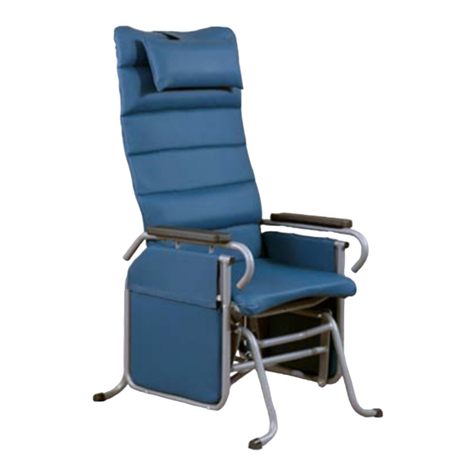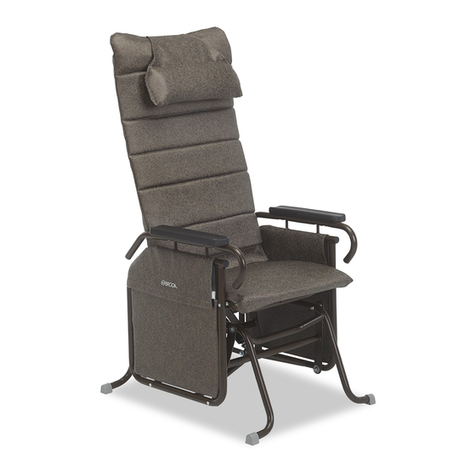
Metal parts and cushions should be wiped completely dry after cleaning. Do not launder vinyl
padding.
Do not allow the chair to air dry. Leaving the chair to air dry and not ensuring the entire chair is
completely dry may cause the frame and components to rust. Solvents such as those found in
spray lubricants should not be used on BRODA Chairs as they can damage moving parts.
Frequency and method of cleaning the chairs should be determined by facility infection control
protocols. If visibly soiled, thoroughly clean the chair immediately as per the cleaning instructions
in this manual.
The cleaning instructions in this manual are guidelines only. Results may vary under actual
conditions. The information does not relieve the user of proper and safe use of the product and all
cleaning agents and consideration for the overall cleaning maintenance of the chair. Cleaning and
care instructions must be followed in conjunction with facility infection control protocols.
BRODA will not accept warranty or liability claims on chairs that have not been cleaned according
to the instructions or cared for in proper regard for patient, caregiver and third party safety and
hygiene. The use of certain agents may be harmful to the surface appearance and lifespan of the
vinyl. BRODA assumes no responsibility resulting from the use of such cleaning agents to the
vinyl.
Touch up paint is available for the powder coated frame. Please call Broda’s Customer Service
Department if touch up paint is required. Do not leave BRODA chairs outdoors as the frame is not
UV protected. Leaving the chairs outdoors could cause the paint to peel.
Formula 409® is a trademark of the Clorox Company.
Fantastik™® is a trademark of DowBrands, Inc.
Trademark of the Dow Chemical Company.
Ivory® is a trademark of Proctor and Gamble
1.13 Preventative Maintenance WARNING
The maintenance on a BRODA Chair will vary with the amount of use and the condition of the
patient using the chair. We recommend regular visual inspection for signs of wear, damage, loose
or missing fittings, and other safety concerns. Also, periodic testing of the chair’s functions is
appropriate. If a breakage, defect, or operational problem is detected, the chair must be repaired,
inspected and tested for function before it is returned to service. For regular use, the Chair should
be inspected and tested on a bimonthly basis. The chair should be inspected and tested as often
as each use if the chair is used:
•By aggressive or agitated patients.
•By patients who have involuntary movement.
•On irregular or sloped surfaces.
•By any unauthorized person.
Do not use any lubricants that contain solvents. Solvents will damage many of the moving
components in the chair. If necessary a white, food grade grease (lubricant) may be used on the
sliding components in the chair. Do not use spray lubricants as they contain solvents.
Inspection
We recommend regular visual inspection of signs of wear, damage, loose or missing fittings, and
other safety concerns. If a breakage, defect, or operational problem is detected, the chair must
be repaired inspected and tested for function before it is returned to service.
We recommend that the chair should be inspected as often as each use, if there is any reason to
be concerned about the possibility of increased wear or loose or missing fittings. At a minimum,





























